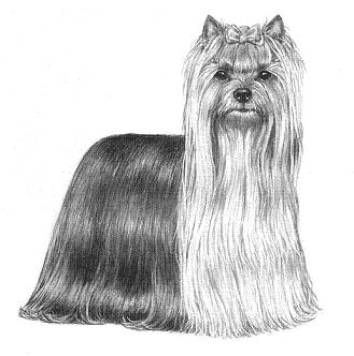
©M.
Davidson, illustr. NKU Picture Library
This illustration does not necessarily show the ideal example of the breed.
ORIGIN:
Great Britain.
DATE OF PUBLICATION OF
THE OFFICIAL VALID STANDARD:
10.11.2011
UTILIZATION:
Companion Dog.
FCI-CLASSIFICATION:
Group
3 Terriers.
Section 4 Toy
Terriers.
Without working trial.
BRIEF
HISTORICAL SUMMARY:
The
Yorkshire Terrier comes from the same locale as the Airedale Terrier and was
first seen around the 1850s. The old Black and Tan Terrier is behind the
Yorkshire Terrier, together with other breeds such as the Maltese and the Skye
Terrier. The current name was accepted in 1870. The breed’s terrier-like
qualities include the hunting instinct, be it for a toy in the house or a
rodent in the garden.
GENERAL APPEARANCE:
Long-coated, coat hanging quite straight and evenly down each side, a parting
extending from nose to end of tail. Very compact and neat, carriage very
upright conveying an important air.
IMPORTANT
PROPORTIONS:
General outline conveying impression of vigorous and well proportioned body.
BEHAVIOUR AND TEMPERAMENT:
Alert, intelligent toy terrier. Spirited
with even disposition.
HEAD
CRANIAL
REGION:
Skull: Rather small and flat, not too prominent or round.
FACIAL
REGION:
Nose:
Black.
Muzzle: Not too long.
Jaw/Teeth: Perfect, regular and complete scissor bite, i. e. upper teeth closely
overlapping the lower teeth and set square to the jaws.
Teeth well placed with even jaws.
Eyes:
Medium, dark, sparkling, with sharp intelligent expression and placed to look
directly forward. Not prominent.
Edge of eyelids dark.
Ears:
Small, V-shaped, carried erect, not too far apart, covered with short hair,
colour very deep, rich tan.
NECK:
Good reach.
BODY:
Compact.
Back:
Level.
Loin:
Well sustained.
Chest: Moderate spring o ribs.
TAIL:
Previously customarily
docked.
Docked:
Medium length with plenty of hair, darker blue in colour than rest of body,
especially at end of tail. Carried
a little higher than level of back.
Undocked: Plenty of hair, darker blue in colour than rest of body, especially at end of tail. Carried a little higher than level of back. As straight as possible. Length to give a well balanced appearance.
LIMBS
FOREQUARTERS:
General
appearance: Legs
straight, well covered with hair of rich golden tan a few shades lighter at
end than at roots, not extending higher on forelegs than elbows.
Shoulder:
Well laid.
Forearm:
Straight.
Forefeet: Round; nails black.
HINDQUARTERS:
General
appearance: Legs quite
straight when viewed from behind, moderate turn of stifle.
Well covered with hair of rich golden tan a few shades lighter at ends
than at roots, not extending higher on hind legs than stifle.
Stifle
(Knee): Moderate turn
of stifle.
Hind
feet: Round; nails
black.
GAIT / MOVEMENT:
Free with drive ; straight action front and behind, retaining level
topline.
COAT
Hair:
On body moderately long, perfectly straight (not wavy), glossy; fine silky
texture, not woolly, must never impede
movement. Fall on head long,
rich golden tan, deeper in colour at sides of head, about ear roots and on
muzzle where it should be very long. Tan
on head not to extend on to neck, nor must any sooty or dark hair intermingle
with any of tan.
Colour: Dark steel blue (not silver blue), extending from occiput to root of
tail, never mingled with fawn, bronze or dark hairs. Hair on chest rich, bright tan.
All tan hair darker at the roots than in middle, shading to still
lighter at tips.
WEIGHT:
Weight:
Up to 3,2 kgs.
FAULTS:
Any departure from the foregoing points should be considered a fault and the
seriousness with which the fault should be regarded should be in exact
proportion to its degree and its effect upon the health and welfare of the
dog.
DISQUALIFYING
FAULTS:
· Aggressive or overly shy dogs
·
Any dog clearly
showing physical or behavioural abnormalities shall
N.B.:
Male animals should have two apparently normal testicles fully descended into
the scrotum.
The latest correction is in
bold characters.
